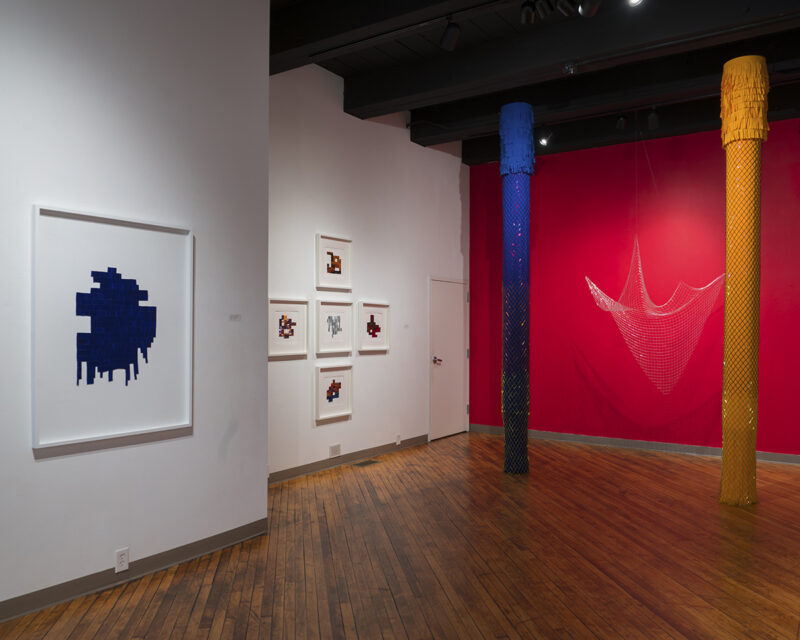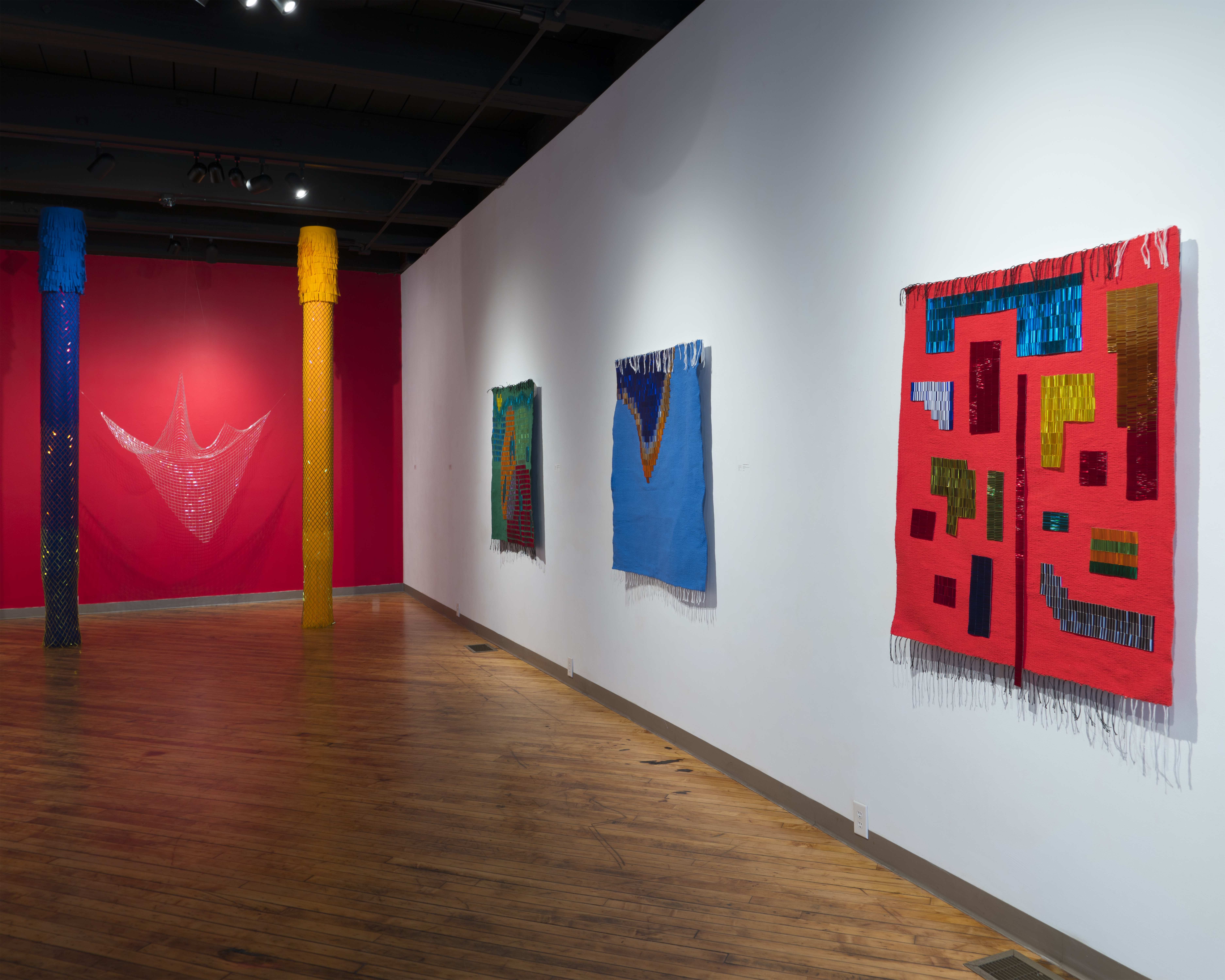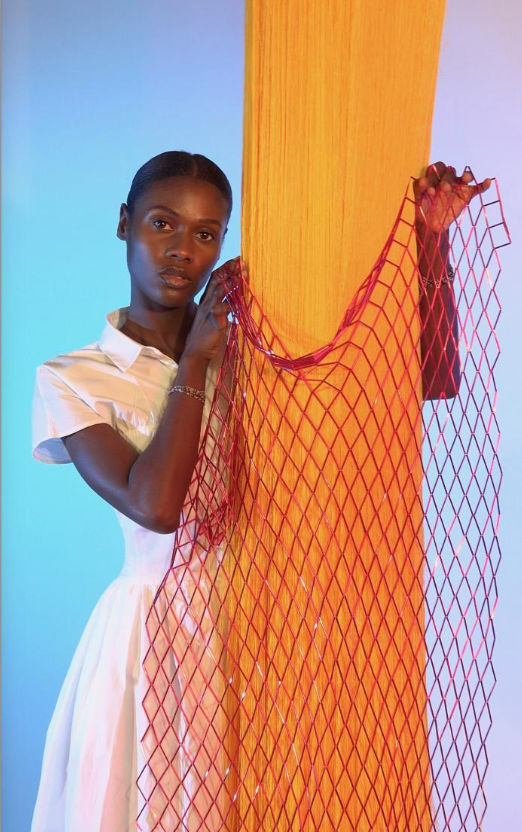Chainky Reindorf at Brunelli Gallery
Artist updates traditions,
blends cultures in her work
Artist Statement
My work is informed and inspired by the visual language of West African textiles and the custom of using these textiles as a means of communication. I am equally fascinated by our widespread relationship with textiles almost exclusively as objects with specific functions. The work I make aims to alter our experience with, and reliance on, these materials as utilitarian by rendering them as meaningful aesthetic objects to be encountered.
As a cosmopolitan citizen, I have become acutely aware of the many nuanced differences between Ghana and the United States; both of which I consider to be home. I have found that by using commonplace materials in multiple manifestations, I can propose comparisons between aspects of the socio-political and cultural spheres of these two spaces.
I fold and mold, bend and coat, weave, and wrap to transform elements of the familiar. I deliberately employ materials, including jute, yarn, plastic lace and wire, that, like textiles, have charged cultural and symbolic histories of their own. This is particularly significant to my work because in moving between inter-continental cultural spaces, these transformed materials are given new meanings and thereby accumulate additional interpretive layers that operate both on the individual and collective level.
***
Interview
Mike Foldes: As a native of Ghana, had you traveled much before coming to the States? And, if you had visited the States previously, what brought you here and where did you go?
Na Chainkua Reindorf: I traveled a lot as a child. Two of my mother’s four siblings lived in London, UK. So I spent a lot of Christmases with my cousins. I visited the States for the first time in 2009 though. I was here in Maine for a week, as part of an exchange program that my high school did with a prep high school. I eventually returned to the States after graduating high school to attend Grinnell College, a small liberal arts college in Grinnell, Iowa.
MF: How did you happen to choose Grinnell College in Iowa for your education? For a person from NY it seems far away; I can’t imagine how far it seemed from Ghana.
NCR: Grinnell College, apart from being quite excellent at recruiting international students, is also one of the top 20 liberal arts colleges in the country. My sister, who had incidentally moved to the States 4 years before me was living in Minneapolis, and so it made sense in both regards to choose such a good school because of its rankings and also because. I would be close enough to my sister.
MF: When did you know you wanted to be an artist, and what prompted you to undertake the study?
NCR: I have always known that I wanted to create. I grew up in a family that appreciated the arts. My parents have been collecting art from local and international artists since I was a baby so I was certainly influenced by having been surrounded by art. Also, I was/and still am taken with the idea of creating beautiful meaningful things that would bring joy and a sense of wonder to people and art seemed to tick all the boxes. Before finally decided to fully pursue art as a career, though, I considered becoming a surgeon (but I had no interest in the sciences) and an architect (the process of designing buildings appealed to me as being more practical than art, but I didn’t like the fact that I would be spending majority of my time creating renders, rather than building everything with my own hands). I wanted to do something where I was personally involved from inception to completion, and so I decided once I entered high school to take it seriously and to pursue art.
MF: Have you traveled extensively outside of Ghana? If so, what places have you visited?
NCR: Not as much as I would like to. But I have been to a few places: UK, Germany, Mexico, I studied abroad in Florence, Italy for a semester while in college, Kenya, neighboring countries like Togo and Benin
MF: Was the education at Grinnell, and later at Cornell, as rigorous as you anticipated before coming here?
NCR: Well my high school was very rigorous and modeled after an international curriculum, and so I knew what to expect coming to the States. I knew what my major was going to be, so I just decided to plan my academic schedule in a way that fulfilled all the requirements, and also served my artistic purpose. I graduated cum laude from college. I also came into Cornell knowing that it was a multi- and inter-disciplinary art program, so I was able to take classes in the art history, fashion, and anthropology departments.
MF: You point out that Ghana is an English-speaking country surrounded by French speaking countries. But, there are as many as 250 languages spoken by indigenous populations in various parts of the country. What other languages or dialects do you speak?
NCR: I speak French (though I am a bit rusty in conversation), I read and understand almost perfectly. I studied it for about 14 years. I studied Italian while abroad, and got pretty good at it. I understand more than I can speak. Of the Ghanaian dialects, I speak Ga, conversationally but understand it more, I understand Ewe and Twi as well.
MF: You practice an enhanced version of weaving and beading that integrates both in some fascinating ways… where did you learn to weave, and where did the idea come from to create patterns with the beads and apply them to the woven backgrounds?
NCR: I actually taught myself, but made sure I got more of the basic understanding of how it worked on a fundamental level, etc., from professors and Ph. D. students in the fashion and design departments in Cornell. I wouldn’t call my weaving enhanced though. I am doing very basic weaving which has been done many years, but perhaps using more recent and contemporary materials like the silver lined bugle bead. I’m also learning more as I go along, looking at books on the topic, watching videos, etc. I also studied techniques that, traditionally, Africans and Native Americans have used, but it is pretty much fundamentally the same wherever you go, depending on what type of loom you are using.
MF: You have said you draw the designs before fabricating the finished pieces… could you share some of these with us? (Do you have drawings we can use as examples next to some of the finished pieces that are in the show at Brunelli?)
NCR: I have attached a preliminary sketch of Chroma, and attached aroma as well for reference. I will share images of the work from the show using wetransfer as the images are quite large.
MF: I love your Shrine, but am most fascinated with Conceal and Reveal… would you please explain where and how these varied concepts originated and what they represent to the Ghanaian culture?
NCR: I was interested in masquerade communities that involved women, because most masquerade communities are male dominant. So it was important to me to find one where women were at the center of the activities, I discovered the Sande Society of Liberia, Sierra Leone, Guinea and Ivory Coast. I modeled the shapes off of the masks from this society and was interested in using a larger than life mask to talk about revealing and concealing bodies. Especially during a climate where women were/are being objectified. This was an immersive installation project that functioned as a contemporary approach meant to undermine the unobstructed male gaze, and redistribute power structures that surround body ownership and policing. This project combined themes of feminism, cultural exploration, the public/private and the mystification of the observed body.
MF: The batik Grief includes multiple drawings of a woman who seems to be writhing, but also includes cigarettes, all against a background of flame… Can you please explain where this idea came from?
NCR: This work was created as a reaction to a tragedy that occurred in Accra, Ghana, where a lit cigarette allegedly caused an explosion at a gas station and killed many people. I was, at the time, dealing with ways I could make meaningful work about topics I cared about in Ghana, while being physically distant from it. It was a sort of performance, but ultimately exists in photograph form, with an illustration I created projected onto myself.
MF: Who – or what – have been the greatest influences on your work? A particular person, tradition, idea, event?
NCR: I have been heavily interested in African traditions that have both managed to stand the test of time, but at the same time keep up with the times. This is why I am so fascinated with masquerade culture, which has existed for centuries, and is still strong today. However, when you look at the types of costumes that are created now, there is an evidence of external influence, and I find it very fascinating. I am also very interested in architecture and artists who make work that interact with space by demonstrating scale and process. A great example is El Anatsui, perhaps one of the best known contemporary African artists living today.
 MF: How did you come to affiliate with the Brunelli Gallery, and do you have additional shows on your schedule? If so, where and when?
MF: How did you come to affiliate with the Brunelli Gallery, and do you have additional shows on your schedule? If so, where and when?
NCR: I was introduced to Brunelli through a mutual friend while I was finishing up my M.F.A. at Cornell University. I had a chance to discuss and show images of my thesis project which piqued John Brunelli’s (gallery director) interest initially. At the time, the gallery was (and still is) hitting the art fair circuit pretty heavily and was looking to expand the breadth of their gallery’s program, which is anchored in process oriented, labor intensive works. The date for my next show has not been decided on yet, but it will most likely be closer to the end of next year.
MF: After nine years in the States, what is your greatest take away about the people and its culture? What can we learn from Ghana, beyond the beauty of your work?
NCR: I think there are many similarities between Ghanaians and Americans, there is a lot of hard work and dedication put into realizing one’s dreams, and this is something I really appreciate. For me, making art is as much a learning process for me as it can be for my audience, so it has become twofold. I make make an effort to understand the vast cultures from my country and continent. My art, I think, is a visual representation of how I process what I have learnt. I have also discovered how many motifs and symbols have near universal recognition even though their meanings are not necessarily the same, it is always eye opening to hear how people understand my work and associate it with ideas that they are familiar with.
MF: Is there anything you’d like to add or say that we may not have addressed?
NCR: I don’t think so! Thank you for your interest and questions!
MF: Again, thank you for sharing your ideas and work with us, and our readers.
NA CHAINKUA (CHAINKY) REINDORF/ARTIST
About the artist:
Na Chainkua Reindorf (b. 1991, Ghana) is a mixed media artist who creates large-scale tapestries and immersive sculptural installations. Her work is an exploration of and an ode to the rich cultural history of West African textiles, especially weaving traditions like Kente, and the complexities of masquerade dress. She purposefully incorporates contemporary materials into her work as a way to create new ways of using these historical textiles to explore ongoing social topics including gender and culture
She primarily uses acrylic and cotton yarn and threads, jute, sisal, wool and wire mesh for her tapestries, and often incorporates beads, sequins, dyed muslin, bamboo and vinyl into her installations. She has exhibited in institutions across the United States in Iowa, Illinois and New York, as well as in Lagos Nigeria and Accra, Ghana.
Most of the photographs in this piece are from Reindorf’s recent solo exhibition at the Anthony Brunelli Gallery in Binghamton, NY.
See: www.anthonybrunelli.com
www.ncreindorf.com
About the interviewer:
Mike Foldes is founder and managing editor of Ragazine.cc. You can read more about him in About Us/Mike Foldes.



Recent Comments